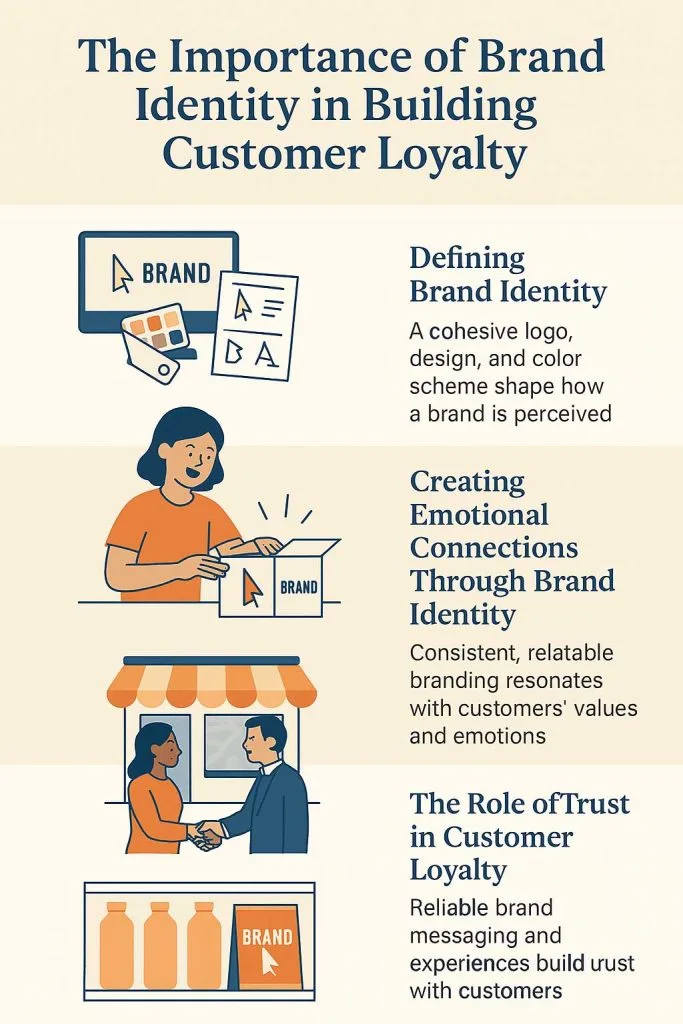Want loyal customers? It all starts with brand identity. Learn how to build trust, retention, and emotional connection.

In today’s fast-paced and competitive market, establishing a strong and recognizable presence is crucial for any business aiming to survive and thrive. One of the key drivers of this success is brand identity, which serves as the foundation for how a company is perceived by its customers.
Why Brand Identity Is Key to Customer Loyalty
Brand identity encompasses all the elements that define a brand, including its logo, design, color scheme, messaging, and overall voice.
However, it’s more than just aesthetics—it is about creating an emotional connection with your audience. When executed correctly, brand identity can play a significant role in building long-term customer loyalty.
Defining Brand Identity: More Than Just a Logo
At its core, brand identity is how a company presents itself to the world. It’s a combination of visual elements, tone, and values that reflect the company’s mission, vision, and unique selling propositions. But in order for a brand identity to truly resonate with consumers, it needs to be consistent, authentic, and aligned with the audience’s expectations and emotions. This consistency builds trust, and trust is the cornerstone of loyalty.

For example, when we think of major brands like Apple, Nike, or Coca-Cola, we don’t just think about their products or services. We also think about their values, messaging, and how they make us feel.
The reason why these brands have become household names is because they’ve crafted a compelling and cohesive brand identity that appeals to their customers on a deeper level. Over time, customers don’t just buy products—they become emotionally invested in the brand itself, which leads to long-term loyalty.
Creating Emotional Connections Through Brand Identity
A strong brand identity is built on emotional resonance, and emotions are what drive customer loyalty. Customers don’t simply choose a brand because of its product or service—they choose it because of how it makes them feel. Whether it’s the sense of empowerment that comes with purchasing a Nike product or the feeling of trust and reliability that comes with using Apple’s products, the emotional connection a customer feels toward a brand is invaluable.
When people identify with a brand’s values, they are more likely to return to that brand over competitors. For instance, many people continue to support brands like Patagonia because they align with the company’s environmental efforts. This emotional connection goes beyond just transactional relationships—it’s about creating a brand experience that resonates with customers’ personal values and lifestyles.

Consistency is key in this process. If a company’s identity shifts too frequently or lacks clear messaging, customers may begin to feel confused or disconnected, diminishing their trust and loyalty. A consistent brand identity ensures that customers know what to expect each time they engage with the brand, whether it’s through its visual elements, messaging, or overall experience.
The Role of Trust in Customer Loyalty
Brand identity is fundamentally tied to the concept of trust. When a company’s messaging, product quality, and customer service are consistently aligned with the brand’s promises, it builds trust with its audience. Trust is the foundation of customer loyalty—without it, customers are less likely to make repeat purchases or recommend the brand to others.
Consider brands like Amazon or Starbucks, which have created strong, reliable identities over the years. Amazon’s brand identity is rooted in convenience, efficiency, and customer satisfaction, while Starbucks has crafted an identity focused on a premium, personalized coffee experience.
Both of these companies have consistently delivered on their promises, and as a result, they have earned the trust of millions of customers around the globe.

A lack of consistency, on the other hand, can erode trust. If a customer has a poor experience with a product or service and feels that the brand is not living up to its promises, they may be hesitant to return. Brand identity shapes these expectations, and any deviation from the established identity can have a significant impact on loyalty.
Brand Identity and Customer Retention
Customer retention is one of the primary indicators of brand loyalty, and it is often driven by a strong brand identity. When customers are emotionally connected to a brand and trust it to deliver quality products and services, they are far more likely to return and make repeat purchases. Moreover, loyal customers are often brand advocates, recommending the brand to friends and family, which can significantly increase the brand’s reach and visibility.

For instance, the brand identity of brands like Tesla or Disney has cultivated passionate fan bases. These customers not only make purchases but also become vocal supporters of the brand. This word-of-mouth marketing, driven by brand loyalty, can be incredibly powerful, as people trust recommendations from friends and family more than traditional advertising.
In today’s highly competitive landscape, retaining existing customers is often more cost-effective than acquiring new ones. A strong brand identity makes it easier to retain customers by creating a sense of belonging and continuity. When customers feel like they are part of a brand’s journey and values, they are more likely to remain loyal over time.
The Role of Brand Identity in Differentiation
Brand identity also plays a crucial role in differentiating a company from its competitors. In a market filled with similar products and services, a well-established brand identity helps customers easily recognize and choose your brand over others.

Strong brand identity elements such as logos, color schemes, and messaging work together to communicate the brand’s personality and value proposition.
For example, when a customer sees the golden arches of McDonald’s, they immediately recognize the brand and the experience associated with it. This immediate recognition contributes to customer loyalty because the brand’s identity has been ingrained in the consumer’s mind through repetition and consistent messaging. The same principle applies to all successful brands—strong identity elements make it easier for consumers to choose and trust the brand, even when other options are available.
Conclusion: Investing in Brand Identity for Long-Term Success
Ultimately, the importance of brand identity in building customer loyalty cannot be overstated. A well-crafted and consistent brand identity fosters emotional connections, builds trust, enhances customer retention, and differentiates a brand from its competitors. When customers feel a sense of belonging and alignment with a brand, they are more likely to remain loyal, make repeat purchases, and advocate for the brand in their circles.
The Power of Brand Identity in Creating Loyal Customers
For businesses aiming for long-term success, investing in a strong and consistent brand identity is not just a marketing strategy—it’s an investment in customer loyalty and business growth.
By continuously nurturing and evolving their brand identity, companies can build lasting relationships with their customers, ensuring that they not only survive but thrive in an increasingly competitive marketplace.

A consistent, clear brand identity isn’t just about aesthetics—it’s your ticket to customer loyalty.
By creating emotional resonance, fostering trust, and offering a consistent experience, your brand becomes part of your customer’s lifestyle.
If long-term success is your goal, investing in brand identity and customer loyalty will take your business further than any one-time sale ever could.

Jessi is the creative mind behind The Coffee Mom, a popular blog that combines parenting advice, travel tips, and a love for all things Disney. As a trusted Disney influencer and passionate storyteller, Jessi’s authentic insights and relatable content resonate with readers worldwide.
